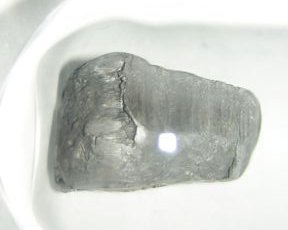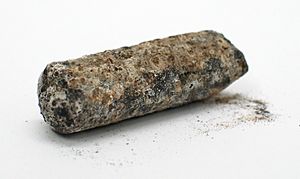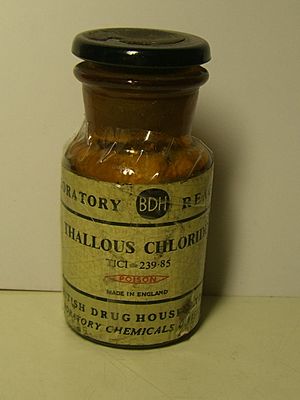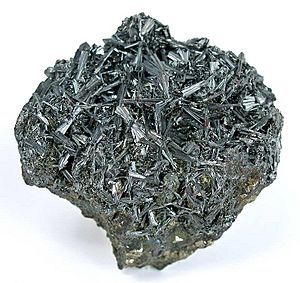Thallium facts for kids
Thallium is a special kind of metal. It's a chemical element with the symbol Tl and the atomic number 81. You can find it in a group of elements called Group 13 on the periodic table. Thallium is a gray metal, but it's very dangerous because it's toxic.
Contents
What is Thallium Like?
How Thallium Looks and Feels
Thallium is a soft, gray metal that you can easily shape. It's so soft you can even cut it with a knife when it's at room temperature. It melts at a fairly low temperature of 304°C. Thallium has many different forms called isotopes, but only two of them are stable and not radioactive. Remember, it's extremely toxic!
How Thallium Reacts with Other Things
Thallium is a metal that reacts easily. When it's in the air, it quickly gets a blue-gray coating, much like lead does when it rusts. If it stays in the air for a long time, a lot of this coating, called thallium(I) oxide, will form. It also reacts with water to create another substance called hydroxide. When thallium burns, it makes a cool green flame! It also reacts with most acids.
Thallium's Chemical Friends
Thallium can form chemical compounds in two main ways, which chemists call "+1" and "+3" oxidation states. The "+1" state is more common and less reactive. These compounds are a lot like those made by potassium or silver. For example, thallium can make a hydroxide that dissolves in water and acts like a strong base. Most other metal hydroxides don't dissolve in water!
One interesting compound is thallium(I) carbonate, which also dissolves in water and is very heavy. It's the only heavy metal carbonate that can dissolve in water. Other compounds, like Thallium(I) bromide, turn yellow in light, just like silver(I) bromide. Thallium(I) sulfide is black, similar to silver(I) sulfide.
The "+3" state compounds are different; they are oxidizing agents, meaning they can take electrons from other substances. The black thallium(III) oxide and thallium(III) hydroxide are the only stable "+3" compounds. They break down when heated. Thallium and its compounds are not very common because they are toxic and can cause pollution.
Common Thallium Compounds (+1)
These compounds are quite stable and don't react much. They form when thallium dissolves in acids or rusts in the air.
- Thallium(I) chloride: A clear solid that does not dissolve in water.
- Thallium(I) hydroxide: A yellow solid that acts as a strong base and dissolves in water.
- Thallium(I) sulfate: A clear solid that dissolves in water.
Less Common Thallium Compounds (+3)
These compounds are oxidizing agents and are not found as often.
- Thallium(III) oxide: A white solid that can act as a semiconductor.
Thallium's Story
Scientists first discovered Thallium in 1861. They found it by looking at its light spectrum, where it showed a bright green line. For a long time, thallium was used in rat poisons. However, many countries stopped allowing this use in the 1970s because of how dangerous it is.
Where is Thallium Found?
Thallium is mostly found in certain types of clay and granite rocks. But it's hard to get it from these places. Usually, thallium is collected from the leftover materials after other ores, like galena, are processed. There's also a mineral called Hutchinsonite that contains thallium.
How We Get Thallium
When metals like lead and zinc are taken from their ores, some unwanted bits, called impurities, are left behind. Sulfuric acid is used to dissolve the thallium from these impurities, turning it into thallium(I) sulfate. Then, a process called electrolysis is used to turn the thallium(I) sulfate into pure thallium metal.
What is Thallium Used For?
Thallium used to be in rat poisons and insecticides. But many countries have now banned or limited its use because it might cause cancer. It's also used in special devices called infrared detectors, which can "see" heat.
Sadly, thallium has been used in some murders. Because it's so hard to detect, it was sometimes called "inheritance powder," like arsenic. Thallium compounds are also used to make special glass for infrared light. In the past, thallium was even used to treat skin infections, but it's too toxic for that now.
A special type of superconductor that works at higher temperatures uses thallium. Also, a radioactive form of thallium was used in medical scans. An alloy (a mix of metals) of thallium and mercury stays liquid at very low temperatures.
Staying Safe Around Thallium
Thallium is very, very toxic. It can even get into your body through your skin. Many of its salts dissolve easily in water. Some of these salts have no color, taste, or smell, but they are still extremely dangerous. Some scientists believe thallium might cause cancer. Thallium can also become a pollutant if waste from metal processing washes away into the environment.
Images for kids
See also
 In Spanish: Talio para niños
In Spanish: Talio para niños






